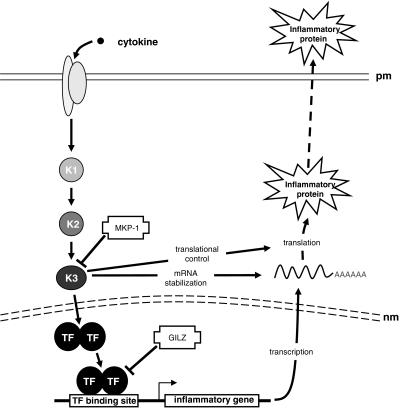Figure 2.
Enhanced expression of MKP-1, but not GILZ, may explain additive effects of LABA/corticosteroid combination therapies in the repression of inflammatory gene expression. A schematic representation of the signalling cascades leading to inflammatory gene expression is depicted with possible targets and sites of action for putative anti-inflammatory glucocorticoid-inducible genes. Activation of a pro-inflammatory cascade, following binding of cytokine to its cognate receptor in the plasma membrane (pm), is shown occurring via a number of kinases (K1–3). The signal crosses the nuclear membrane (nm) and leads to transcription factor (TF) activation and the production of inflammatory gene mRNAs. Under the influence of further kinase cascades (here K1–3), the mRNA is stabilized and translated into protein. Finally, many proteins (for example cytokines, chemokines) are exported into the extracellular space for biological function. Sites of action of the two glucocorticoid-inducible genes, MKP-1 and GILZ, are indicated. MKP-1 is an inhibitor of the MAP kinase family of protein kinases and may, therefore, impact on numerous cellular mechanisms, including the activation of transcription, mRNA stability and translation. GILZ inhibits key inflammatory transcription factors (NF-κB and AP-1). AP-1, activator protein-1; GILZ, glucocorticoid-inducible leucine zipper; LABA, long-acting β2-adrenoceptor agonist; MAP, mitogen-activated protein; MKP, mitogen-activated protein kinase phosphatase; NF-κB, nuclear factor κB.

